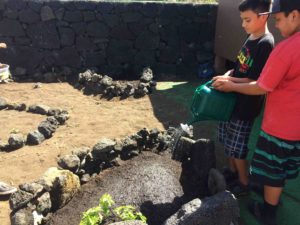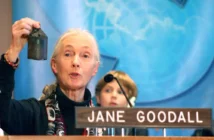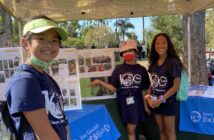This past September Something Good in the World, was honored to present its Children’s Peaceful Garden design at the United Nations International Day of Peace, representing Roots & Shoots. After this life-changing event, in which we had the privilege of describing our project to hundreds of attendees, I began spreading the word about this design beyond the New York area where the Children’s Peaceful Garden originated.
Because we’ve designed and built five Children’s Peaceful Gardens over the past 17 years, I have a sense of what a successful children’s garden requires. I wanted to help teachers in challenging circumstances troubleshoot their Roots & Shoots school garden issues. I knew from experience that teachers really need start-up assistance so I volunteered to become an R&S “Garden Ambassador” to help schools overcome obstacles.
 Recently, Something Good in the World has been collaborating with a small charter school in Hawaii. The Ka’u Learning Academy is located in one of the poorest performing school districts in the state and Hawaii is ranked as one of the poorest performing states in the US, in terms of academic achievement. In situations where people don’t have access to healthy food, there can be a lack of knowledge about the origins of foods and how to make healthy choices, which contributes to poor health and nutrition.
Recently, Something Good in the World has been collaborating with a small charter school in Hawaii. The Ka’u Learning Academy is located in one of the poorest performing school districts in the state and Hawaii is ranked as one of the poorest performing states in the US, in terms of academic achievement. In situations where people don’t have access to healthy food, there can be a lack of knowledge about the origins of foods and how to make healthy choices, which contributes to poor health and nutrition.
Something Good in the World is dedicated to offering free farm-based education programs to children who live in these “food deserts.” Access to fresh food is difficult in these places and schools provide many of the students’ meals for free. Despite what you might imagine on an island with trees dripping with avocadoes, mangoes, papayas, and bananas, the district of Ka’u is in fact a certified food desert.
The first step in helping set up their garden was to encourage their teacher, Audra Zook, to apply for a Roots & Shoots mini-grant. She took up the suggestion and named her project, “Where’s the Food?” In Ka’u, you can forage fruits and catch fish, if you know how. But what if you want to buy some veggies? There are only two tiny grocery stores in the town of Na’alehu where the school is located, and you have to own a car to get to more affordable stores. In terms of fresh vegetables, there are farmer’s markets, but these are pricey and many people are on food stamps, which aren’t accepted at local markets. Most affordable foods are processed, which is less healthy and can lead to obesity and diabetes.
At one time in history, the district of Ka’u sustained 100,000 people on locally grown foods. Today, 85% of the food is imported. One goal of the school garden initiative is to encourage children and their families to supplement their tables with homegrown, fresh veggies and herbs.
Meeting with Audra’s garden class was a total pleasure. We made “worm cake” (compost for worms), designed their Children’s Peaceful Garden, and collected lava rocks to delineate the spaces for growing herbs, cactus, and pineapples! The children had great fun naming their worms for the worm bin, and visiting them each day to feed them and give them a misting of water. They collected lava rocks to create an oval for planting the pineapple garden and learned all about how pineapples grow.

Barbara and Ka’u students making worm cake.
We found solutions to many of the obstacles Audra faced. Instead of planting veggies from seeds in the hard and dry ground, they’d have better success getting seedlings from a local organic farm. Rather than planting cash crops, like coffee or sugar cane that required a lot of water, it is better to go with native plants that need less water. We looked at a roof on their outdoor classroom that sloped down to the garden and was perfect for a rain barrel and drip irrigation system.
By the end of the week, a new Children’s Peaceful Garden was born. The garden is dedicated to peaceful play and integrated with the school curriculum. It teaches children the origins of their food and how to make healthy choices while supplementing their table at home. I received an email from Audra, telling me she had consulted with a local teacher who translated the name of the garden into Hawaiian so the children could connect with their language. The sign at the entrance reads “Ka Mala Maluhia” = The Garden Peaceful.
Tips For Starting a Peaceful Garden:
- Use natural shapes to delineate garden beds, rather than straight rows or squares – imitate the curves of nature. Flowers naturally grow in “clumps” and vegetables and herbs like to do this too.
- Keep the gardens within the larger garden small – remember: small is sustainable. Make sure children can easily reach in to weed or harvest, otherwise make pathways they can walk to get inside.
- Make signs for each garden – it’s fun for children to name each garden. The signs can be simply made on paper or cardboard and laminated and attached to a stake, or they can be more long-lasting and painted on ceramics that are glazed and fired in a kiln.
- Have each child research one plant in the garden and bring in a one-page description of the plant with a photo, as well as any folklore associated with the plant, what it’s medicinal uses are, if it’s edible, etc.
- Collaborate with experts in the field so that you are not reinventing the wheel. Local farmers, gardeners, and landscapers love to share their knowledge with children – they want more gardens to grow in the world!
- Find out what your students already know and include that information in your gardening – it is likely that some students garden at home too.
- Be sure that the majority of the garden is filled with perennial native plants, as these tend to be hardy, pest-resistant, and drought-resistant. Experiment with annuals and seeds, but be sure that most of the garden is growing successfully and maintaining itself on its own. Teachers are busy, so focus your energies on what is already working and then add little by little, like ripples going outward from your central garden area.






